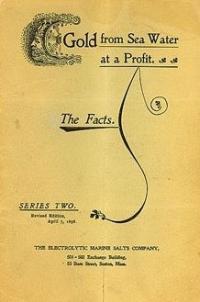
Prospectus for The Electrolytic Marine Salts Company
On April Fool’s Day, a repost about not an April Fool’s Day prank but a hoax and a swindle. In October of 1897, at the height of the Alaskan Gold Rush, two men, Prescott Ford Jernegan, a Baptist minister, and Charles Fisher, both from Edgartown, Martha’s Vineyard, arrived in Lubec, Maine to establish a facility to extract gold from seawater.
Klondike: Lubec’s Gold from Sea Water Hoax
The two newcomers leased Hiram Comstock’s tidal grist mill located at Mill Creek in North Lubec. According to Reverend Jernegan in the prospectus, he prepared for potential investors, “Millions of dollars in gold were flowing through Lubec Narrows every single day.”
Between October of 1897 and February 1898, approximately one hundred men were employed in the conversion of the grist mill to a gold extraction factory. A “machine room” and a “laboratory” were constructed. Beneath them, in the water, were placed specially constructed wooden boxes called accumulators, for collecting the gold content of the seawater that flowed through them. More critical to the top-secret operation was the high wood and barbed wire fence with its “No Admittance” signs that surrounded the facility.
The following account appeared in The Lubec Herald in July 1898: “The inlet to Mill Pond accommodated 240 accumulators of which sixty were pulled up each week. Thus each box was underwater a month before its turn came to be examined. During that time the water, chemicals, and electricity had time to work their magic.” Apparently, nothing more elaborate than a cast iron pot was at the heart of this fantastic device. It was later learned that Charles Fisher, an accomplished diver and the brains behind the operation, had in fact planted the so-called “magic”- the small quantities of gold extracted by the accumulators – in them. At regular intervals, just prior to the accumulators being raised from the water, he would, under cover of darkness, salt each box with the gold. This gold was sent to New York and proved to be enough to convince investors that a fortune was to be had.
Thousands of shares were sold, primarily to investors in Massachusetts, New York, and Connecticut. Jernegan and Fisher designed and published an elaborate prospectus to attract and convince potential shareholders. Among the incredible claims made in this document was the following: “One is at a loss to comprehend the enormous wealth floating in solution in the ocean. At the lowest estimate, a cubit mile of seawater contains gold to the value of $65,000,000. It is probably nearer the mark to place it at $100,000,000.”
So successful was the first plant at Mill Creek that construction began on a second, much larger facility at the nearby canal in North Lubec that would contain 5000 accumulators and employ hundreds of men. So many came in search of work at the new plant that it was difficult to find boarding space in town. Over 700 laborers were involved in the construction. Many were Italian immigrants lured from working on the railroad in Machias by the promise of higher wages. They lived in two large camps near the site.
By July of 1898, both Prescott Jernegan and Charles Fisher had disappeared and the scheme collapsed. Jernegan went on to become a respected school teacher in the Philippines where he authored a history of the Islands.

Fritz Haber, who won the Nobel prize in physics in 1918, worked on ways to produce gold from seawater after WW 1. He thought it might be a way for Germany to pay off its war debts.
If only they had spent their time finding ways of removing phosphates from rivers and coastal waters!
Jean-Pierre Declemy? Lubec isnt known for farming. The most we grow around these parts are tourists that build magnificent houses the locals cant afford. Otherwise its mosquitos and black flies. You have to go inland to find farm land and even then most of the farmers arent farming much anymore.
Lubec is semi coastal community. 95% of coastal communities get their income from fishing.
Thanks Willy
Just my imagination running riot again:
I know it was a scam but supposing they had found a way of extracting gold from sea water – all it would have done would be to debase the value of gold. However, if they had perfected a way to remove phosphate the benefits would have been much greater – they could sell the phosphate back to the farmers again and again and again and made themselves and the investors loads of money 🙂